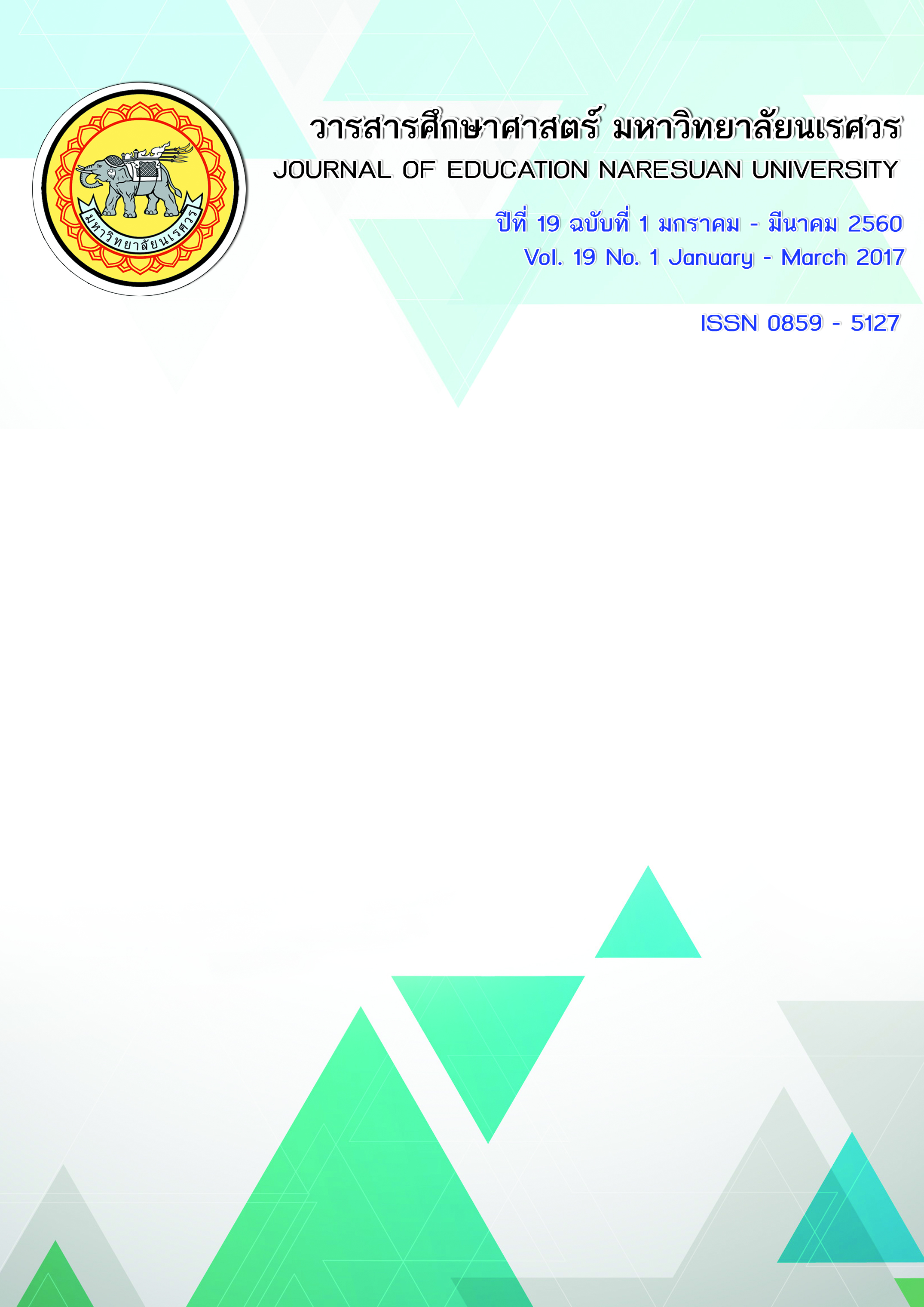การพัฒนาหลักสูตรเน้นสมรรถนะการพัฒนาหลักสูตรท้องถิ่น ตามแนวคิดการเรียนรู้ร่วมกันที่เน้นการคิดไตร่ตรองสำหรับครู
Main Article Content
Abstract
การวิจัยครั้งนี้มีจุดมุ่งหมายเพื่อพัฒนาหลักสูตรเน้นสมรรถนะการพัฒนาหลักสูตรท้องถิ่นตามแนวคิดการเรียนรู้ร่วมกันที่เน้นการคิดไตร่ตรองสำหรับครู ดำเนินการโดยใช้กระบวนการวิจัยและพัฒนา 4 ขั้นตอน ประกอบด้วย ขั้นตอนที่ 1 การศึกษาข้อมูลพื้นฐานที่จำเป็นต่อการพัฒนาหลักสูตร โดยการสอบถามสภาพการดำเนินงานด้านหลักสูตรสถานศึกษา สภาพปัญหาและความต้องการในการพัฒนาหลักสูตรท้องถิ่นของครูผู้สอนในโรงเรียนสังกัดสำนักงานเขตพื้นที่การศึกษาประถมศึกษาเพชรบูรณ์ เขต 1 จำนวน 153 โรงเรียนๆ ละ 1 คน รวมจำนวน 153 คน และสัมภาษณ์กลุ่มผู้เชี่ยวชาญ 3 กลุ่ม ได้แก่ กลุ่มผู้เชี่ยวชาญด้านการพัฒนาหลักสูตรและการพัฒนาครู จำนวน 4 คน ด้านการจัดการเรียนรู้ร่วมกันและการคิดไตร่ตรอง จำนวน 3 คน และด้านท้องถิ่น จำนวน 3 คน เพื่อนำข้อมูลที่ได้มาสังเคราะห์ในการกำหนดองค์ประกอบของหลักสูตรให้มีความเหมาะสมสอดคล้องกับสภาพปัญหาและความต้องการของครู ขั้นตอนที่ 2 การสร้างและตรวจสอบคุณภาพของหลักสูตร โดยผู้เชี่ยวชาญตรวจสอบความเหมาะสมและนำหลักสูตรไปทดลองนำร่องเพื่อศึกษาความเป็นไปได้ ขั้นตอนที่ 3 การทดลองใช้หลักสูตรกับกลุ่มตัวอย่างซึ่งเป็นครูผู้สอนของโรงเรียนบ้าน กม.2 อำเภอเมือง จังหวัดเพชรบูรณ์ จำนวน 12 คน ที่ได้มาด้วยวิธีการสุ่มแบบเจาะจง ใช้เวลาทดลอง 25 วัน 143 ชั่วโมง โดยจัดกิจกรรมการเรียนรู้ 5 ขั้น ได้แก่ ขั้นที่ 1 เผชิญสถานการณ์ผสานข้อมูล ขั้นที่ 2 ระดมความคิดพิชิตสถานการณ์ ขั้นที่ 3 ร่วมค้นหาข้อสรุปสู่การปฏิบัติ ขั้นที่ 4 เสนอผลงาน/ไตร่ตรองการเรียนรู้สู่ความรู้ใหม่ ขั้นที่ 5 สะท้อนผลการเรียนรู้สู่ทางเลือกใหม่ ขั้นตอนที่ 4 การประเมินหลักสูตร โดยสอบถามความคิดเห็นของครูที่มีต่อการเข้าร่วมกิจกรรมการเรียนรู้ของหลักสูตร การวิเคราะห์ข้อมูลใช้สถิติ ค่าร้อยละ ค่าเฉลี่ย ความเบี่ยงเบนมาตรฐาน และการทดสอบ (Wilcoxon Signed-Rank Test) ผลการวิจัย พบว่า
1. ผลการศึกษาสภาพปัญหาและความต้องการในการพัฒนาหลักสูตรท้องถิ่น พบว่า สภาพปัญหาในการพัฒนาหลักสูตรท้องถิ่นอยู่ในระดับมาก และครูผู้สอนมีความต้องการในการพัฒนาหลักสูตรท้องถิ่น อยู่ในระดับมากเช่นเดียวกัน และผลการสัมภาษณ์ผู้เชี่ยวชาญมีความคิดเห็นตรงกันว่า ควรมีการพัฒนาหลักสูตรเน้นสมรรถนะการพัฒนาหลักสูตรท้องถิ่น ตามแนวคิดการจัดกิจกรรมการเรียนรู้ร่วมกันที่เน้นการคิดไตร่ตรอง
2. ผลการสร้างและตรวจสอบคุณภาพหลักสูตรพบว่า หลักสูตรเน้นสมรรถนะการพัฒนาหลักสูตรท้องถิ่นตามแนวคิดการเรียนรู้ร่วมกันที่เน้นการคิดไตร่ตรองสำหรับครู มี 7 องค์ประกอบ ได้แก่ หลักการ จุดมุ่งหมาย สมรรถนะครูด้านการบริหารหลักสูตร สาระการเรียนรู้ แนวการจัดกิจกรรมการเรียนรู้ แนวการใช้สื่อการเรียนการสอน และแนวการวัดและประเมินผล เนื้อหาโครงสร้างหลักสูตรประกอบไปด้วย 5 หน่วยการเรียนรู้ ได้แก่ หน่วยที่ 1 สามัญทัศน์การพัฒนาหลักสูตรท้องถิ่น หน่วยที่ 2 สามัญทัศน์การประเมินหลักสูตร หน่วยที่ 3 การสร้าง/พัฒนาหลักสูตรท้องถิ่น หน่วยที่ 4 การประเมินการใช้หลักสูตรท้องถิ่น และหน่วยที่ 5 การนำผลการประเมินไปใช้ในการพัฒนาหลักสูตร การจัดกิจกรรมการเรียนรู้ของหลักสูตร 5 ขั้น ได้แก่ ขั้นที่ 1 เผชิญสถานการณ์ผสานข้อมูล ขั้นที่ 2 ระดมความคิดพิชิตสถานการณ์ ขั้นที่ 3 ร่วมค้นหาข้อสรุปสู่การปฏิบัติ ขั้นที่ 4 เสนอผลงาน/ไตร่ตรองการเรียนรู้สู่ความรู้ใหม่ ขั้นที่ 5 สะท้อนผลการเรียนรู้สู่ทางเลือกใหม่ การตรวจสอบคุณภาพหลักสูตรและเอกสารประกอบหลักสูตร พบว่ามีความเหมาะสมอยู่ในระดับมากที่สุดและการศึกษานำร่อง พบว่า หลักสูตรสามารถนำไปใช้ได้จริง
3. ผลการทดลองใช้หลักสูตร พบว่า ความสามารถในการพัฒนาหลักสูตรท้องถิ่น ซึ่งประกอบด้วย ความรู้ความเข้าใจในการพัฒนาหลักสูตรท้องถิ่น ความสามารถในการสร้าง/พัฒนาหลักสูตร และความสามารถในการประเมินการใช้หลักสูตรและการนำผลการประเมินไปใช้ในการพัฒนาหลักสูตรมีผลโดยภาพรวมอยู่ในระดับดีมาก มีคะแนนเฉลี่ยเท่ากับ 19.09 คิดเป็นร้อยละ 84.98
4. ผลการประเมินหลักสูตร พบว่า ครูมีความคิดเห็นต่อการเข้าร่วมกิจกรรมการเรียนรู้ของหลักสูตรอยู่ในระดับมาก
THE DEVELOPMENT OF TEACHER COMPETENCY-BASED CURRICULUM ON LOCAL CURRICULUM DEVELOPMENT USING COLLABORATIVE LEARNING AND REFLECTIVE THINKING
This research aimed to develop the Development of Teacher Competency-Based Curriculum on Local Curriculum Development using Collaborative Learning and Reflective Thinking. How to implement process research and development (Research and Development) was divided into four steps: Step 1 to study the basic information needed to develop the curriculum by querying the operating conditions of the curriculum, the problems and needs in the local curriculum development of 153 teachers in 153 schools under the jurisdiction of primary education Phetchabun region 1, and three groups of experts; 4 teachers in the aspect of professional development, curriculum and teacher development; 3 teachers in the aspect of management learning and the thoughts and three people in aspect of the local to synthesize to determine the information of course fitting with the problems and needs of teachers Step 2. To create and monitor quality of course by experts examining the proper and the curriculum pilot to study the feasibility. Step 3 trial program to sample, the 12 teachers of the school km 2, Muang Phetchabun province with the sampling time trial; 25 days, 143 hours of event to learn five steps: step 1 situation merge step 2 brainstorming win situation Step 3 together for a conclusion to the implementation steps. 4 Presentation/ reflective learning new knowledge Step 5 to reflect a new way of learning. Step 4 to evaluate program by querying the satisfaction of the teachers who are participate in learning activities of the course. Data analysis, statistics, percentages, averages and standard deviation of the test (Wilcoxon Wilcoxon Signed-Rank Test). The results showed that:
1. Results of the study of the problems and the need to develop local programs that addressed problems in local curriculum development was on a massive scale. And needs of teachers to develop a local curriculum was in high level the same as the results of the experts' opinion. Curriculum development should be focused on the performance of local curriculum development based on the concept of shared learning activities focused on thinking.
2. Results of quality monitoring program found that the course focuses on the performance of local curriculum development based on the concept of mutual learning-focused thinking for teachers with seven elements including principles, objectives, teacher performance on the course administration, learning activities, media instruction, measurement and evaluation. The learning activities consists of five steps: Step 1 merging situation Step 2 brainstorming to win situation Step 3 contemporary conclusions into action Step 4 presentation/reflective learning. Step 5 to reflect new knowledge to learn into a new choice. Content curriculum consists of five units, unit 1 common vision of local curriculum development unit 2 common paradigm to assess the local curriculum unit 3 building and developing local programs Unit 4 evaluating the use of local curriculum unit 5 results of the assessment are used to develop the course. Experts assessing the curriculum focuses on courses were suitable for performance at the highest level. The pilot study found that the course can be put into practice.
3. Results of the trial showed that the competency to develop the course curriculum consisting of cognitive development in local courses, ability to create/ develop and the ability to evaluate the program and its results used to develop the course. The overall effect is very good, an average score of 19.09, 84.98 percent.
4. The evaluation found the opinion of teachers who participated in training towards the training curriculum was at a very good level both in total and on every item.
Article Details
The owner of the article does not copy or violate any of its copyright. If any copyright infringement occurs or prosecution, in any case, the Editorial Board is not involved in all the rights to the owner of the article to be performed.


